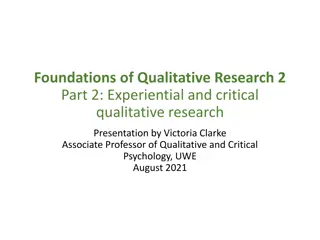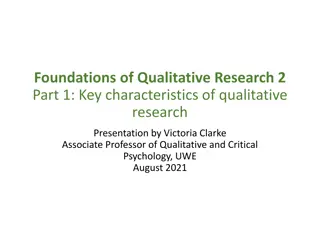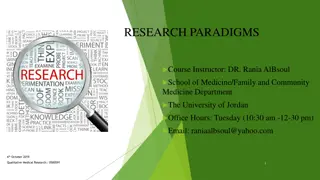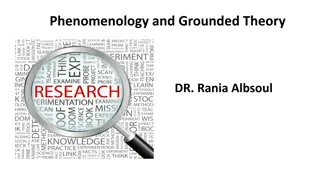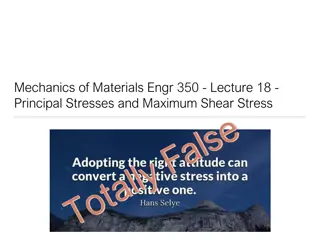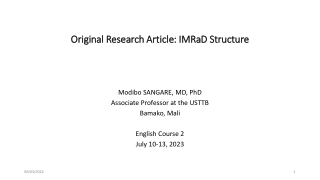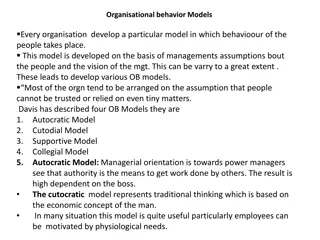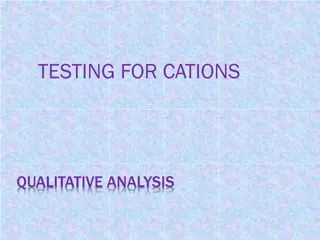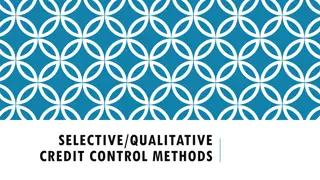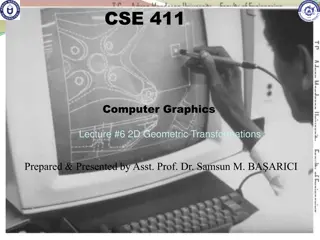Understanding Qualitative Research: Foundations and Orientations
Explore the foundations of qualitative research and orientations to meaning in Big Q qualitative methods. Delve into the values, characteristics, and theoretical underpinnings of qualitative inquiry, and reflect on the significance of meaning-making in research. Consider the role of subjectivity in research and the need to acknowledge and articulate one's positioning and assumptions. Pause for self-reflection on the various factors shaping your role as a researcher and your approach to the research process.
Download Presentation

Please find below an Image/Link to download the presentation.
The content on the website is provided AS IS for your information and personal use only. It may not be sold, licensed, or shared on other websites without obtaining consent from the author. Download presentation by click this link. If you encounter any issues during the download, it is possible that the publisher has removed the file from their server.
E N D
Presentation Transcript
Foundations of Qualitative Research 1 Part 3: Orientations to meaning in Big Q qualitative Presentation by Victoria Clarke Associate Professor of Qualitative and Critical Psychology, UWE August 2021
PowerPoint slides from the Braun, Clarke & Hayfield Qualitative Methods Online Teaching & Learning Resources Collaboration (QMOTLRC) Image of a white woman - Virginia Braun - a head and shoulders shot, she is wearing a red and white striped long sleeved top and glasses, and has her hands resting on either side of her face
Topic overview oThis is the first of two lectures each divided into three parts - exploring the values, characteristics and theoretical foundations of qualitative research. oThe aim of this first lecture is to provide an accessible introduction to qualitative research, for those with some research training. We try to use minimal specialist terminology (this will come in the second lecture!). oThis lecture explores different understandings of qualitative research as providing researchers with tools and techniques and as providing both tools and techniques, and research values. oWe then explore the central importance of meaning and meaning-making to qualitative enquiry and some different orientations to meaning. oThere are some opportunities to pause the recording and reflect on your knowledge and understanding of qualitative research.
Lecture overview oPart 1: What is qualitative research? oPart 2: Meaning and meaning-making in Big Q qualitative oPart 3: Orientations to meaning in Big Q qualitative
The double hermeneutic Hermeneutic = interpretation, sense-making. If participants sense-making is partial, situated etc does that mean researchers sense-making is also? Or can we detach ourselves from our subjectivity? We are just as subjective as our participants. Whereas small q researchers seek to control subjectivity, Big Q researchers embrace it. But we must develop the capacity to know, reflect on and articulate our positioning, assumptions etc. As previously mentioned, we must strive to own our perspectives .
Pause for reflection 1 You may like to pause the recording and reflect on the assumptions and values that shape and situate you as a researcher, including: Intersections of socio-demographic positionings marginality and privilege (sex/gender, race, class, sexuality, disability, age ) in relation to your participants. Are you an insider or an outsider research? Personal background and life experiences. Research training and research experiences. Political and ideological commitments (both overt and implicit). Your research values and assumptions (what counts as good research?) Personal experiences of, and assumptions about, the topic you are researching If you are not currently planning a research project, we suggest you reflect on your assumptions in relation to the example we started with of LGBT students experiences of university life.
Orientations to meaning To read more about a hermeneutics of empathy & suspicion - associated with the work of French philosopher Paul Ricoeur - see Smith et al. (2009) & Willig (2013). A key practice for qualitative researchers is making- sense of the meanings in their data. How can we orient to meaning? There is no one way of doing this a useful distinction is between empathic sense-making and suspicious sense-making. Empathic sense making is often associated with terms like giving voice , exploring lived experienced , providing a thick description of the rich tapestry of people s lives and philosophies like phenomenology (concerned with subjective sense-making).
Orientations to meaning continued Suspicious sense-making is associated with terms like interrogate, deconstruct, critical and philosophies like constructionism, post- structuralism (concerned with social meaning- making and its relationship to power). This distinction broadly maps onto views of language as reflective of underlying experience and language as active and performative, as doing things, producing truths and realities.
Hermeneutics of empathy This is about trying to step into someone s shoes and see the world as they see it, and try to unpick how and perhaps also why they make sense in the way that they do. Not just summarising or describing what people say (although this is common). Exploring how people s sense making is situated and positioned what might it reveal about their social location? The focus is on staying close to peoples realities and meanings and understanding the person-in-context. It doesn t mean that we agree or ally with someone s sense making (qualitative research isn t about judging whether people have it right or wrong).
Hermeneutics of suspicion This approach is about not taking things at face value interrogating meaning and the assumptions and world-views meanings rely on. Exploring the effects and implications of particular meanings what do they open up and close down? What realities do they create? Why and how is this sense making intelligible (in this context)? Meaning is firmly located in a social context and there is concern for how power and meaning intertwine which meanings are socially dominant and normative? Which are marginal? Which are resistant? The focus may shift from the individual to the social (to discourse socially generated meanings). It is not about being critical in the sense of arguing with data explaining why someone s sense making is faulty or illogical.
Pause for reflection 2 Empathic or suspicious interpretation? Read the following four examples of qualitative studies and decide if they are an example of empathic or suspicious interpretation: Example 1: Recreational pole dancing. Example 2: Problematic skin picking. Example 3: Male body hair. Example 4: Living with alopecia. For each study, we provide extracts from the analysis section of the report. Our take on each study follows.
Example 1: Whitehead & Kurz (2009) - Extract 1: Student focus group 2 630 Alice: [U::m](.) well I think if you re doing it for fitness it can be empowering (.) 631 because it s like (.) if you re having fun doing it and you re getting fit at 632 the same time (.) you re gunna (.) you re gunna feel good about [yourself] 633 Interviewer: [Yep] 634 Alice: cos you re like oh I m having fun at this and I m getting fit at the same 635 time (.) but I don t think it s always empowering for like (.) the women 636 in the clubs because (0.5) I don t think the men are going to see the 637 women (.) they re going to see their bodies they don t see them as a 638 woman (.) they just see them as something to look at (.) something pretty 639 to see (h)
Example 1: Whitehead & Kurz (2009) continued The construction of pole dancing as an activity for fun and fitness by Alice in extract 1 serves an important rhetorical function. Alice compares and contrasts recreational and professional pole dancing, stating at different points in the extract that I don t think it s always empowering (line 635, emphasis added) and if you re doing it for fitness it can be empowering (line 630, emphasis added). This serves to construct the act of dancing around a pole as an inherently neutral activity that can be seen as empowering or disempowering, as a function of the specific context of its enactment. In relation to this, contextual qualifiers such as having fun getting fit and hence, feeling good about yourself (line 632) work to characterize recreational pole dancing as empowering. In direct contrast, the participant constructs professional pole dancing as disempowering, on account of the assumed subjective position of the male spectators. Specifically, the male spectator is constructed as seeing the body rather than the woman and as not seeing them as a woman, but rather as an object (line 637). This serves to discursively locate the professional pole dancer as sexually objectified. Thus, the discursively constructed contextual environments of fun and fitness verses sexual objectification work to position pole dancing itself as neutral, with the context within which the behavior is enacted as either empowering or disempowering.
Example 2: Anderson & Clarke (2019) - Theme 1: get out of my skin An absolute disgust for and intolerance to bumps, skin gunk (E68), imperfections within the pores and on the surface of the skin were frequently evident. There appeared to be little motivation to cause the skin itself damage, rather the impact on skin appears to be unintended collateral damage from removing what were perceived to be foreign entities and substances. Many accounts described being unable to tolerate anything that was experienced as abnormal (E39) and needing to get every last bit out with disregard for the damage done to the skin:
Example 2: Anderson & Clarke (2019) continued It seems like I HAVE to get all the disgusting stuff out of my skin. (E35) I hate/love it. I love getting this SHIT out of my face [ ] I use tools and tweezers and razor blades to get that one last bit out destroying my skin in the process. (E53) As the above extract shows, the language used to describe extracting perceived abnormalities was sometimes aggressive and the process was seen as a battle (E72). This may suggest a separateness of the self from the contents of the skin, warranting a forceful or attacking response: I attacked it into submission (E68).
Example 3: Terry and Braun (2016) - Theme 1: It is just hair, perfectly natural part of being a man if you happen to have it [ ] Participants who identified male body hair as natural would often evoke a natural sexual dimorphism, with men s hairiness contrasted with women s bodily hair state. Men are physiologically different to women, we ought to look different too. (P256, male, 34, heterosexual, married) Men are meant to be hairy naturally because of high testosterone. (P133, male, 32, heterosexual, single) Men are naturally supposed to have more body hair than women. (P260, male, 34 heterosexual, long term partnership)
Example 3: Terry and Braun (2016) continued In making such ascriptions, participants state (or infer) that men should be hairy, and women should be hairless . Although women have less terminal (and therefore less visible ) body hair than men on average (Price & Griffiths, 1985), such formulations also evoke two different things: men s biologically-located embodiment (a certain au-naturale hairiness) and women s socially located embodiment (worked upon and produced hair-free bodies). These accounts work to naturalise and essentialise these differences, and to thus situate male body hair as beyond the realm of removal. In fact, all three of the extracts above, use imperatives ( ought , meant , supposed ) about men having body hair to emphasise this point. Men have body hair, and men should have body hair, case closed.
Example 4: Davey et al. (2019) - Theme 1: It s (not) only hair Hair loss was emotionally devastating for many, and could lead to depression, anxiety and, in some instances, suicidal thoughts. The pace and unpredictability of hair loss were often mentioned as particularly disturbing and shocking. Hair loss was frequently likened to bereavement or loss of a limb, emphasizing that the impact extends beyond the physical body to self-confidence, self-esteem and identity. References to symbolic and cultural meanings attached to hair were common; monsters, aliens and bald evil characters were mentioned, such as Voldemort from the Harry Potter books and films, and some women likened hair loss to mastectomy as breasts and hair both signify femininity. Many considered themselves ugly, unattractive and shameful; distressing recent or past behaviours from other people including shouting or staring in the street, and bullying at school contributed to these beliefs.
Example 4: Davey et al. (2019) continued Yet alongside this, was the contradictory sense of not being entitled to distress or sympathy because hair loss is not life-threatening (e.g. P10, female; P87, male), unlike the cancer suffered by patients who receive chemotherapy, for whom they were often mistaken. Many described being told it is only hair (e.g. P47, female) by healthcare professionals, which deepened distress; not only were feelings of loss, grief and emotional devastation not acknowledged, but also the sense of not being entitled to those feelings or to support was reinforced. For a few participants it was only hair, and others strived for this position, describing a process in which the shallowness of an appearance- obsessed culture could be rejected by valuing the inner self and accepting the outer self.
Empathic or suspicious interpretation? Example 1: Recreational pole dancing - suspicious. Example 2: Problematic skin picking - empathic. Example 3: Male body hair - suspicious. Example 4: Living with alopecia - empathic.
Qualitative research and social justice A concern for social justice isn t a necessary feature of qualitative research, but it often is. Many qualitative approaches have an overt concern with social justice (e.g. action research and other participatory approaches). Empathic research that aims to give voice is often concerned with making visible the experiences of the socially marginalised and vulnerable (e.g. people of colour, trans people). Suspicious research is often concerned with understanding how socially dominant meanings operate and come to dominate and highlighting moments of resistance and possibilities for change.
Pause for reflection 3 Reflect on your qualitative research values Are you drawn to small q or Big Q qualitative? Are you an archaeologist or an artist? What types of meaning are you interested in? Psychological, social? How do you understand the relationship between individual experience and the social context? Are you drawn to a hermeneutics of empathy or suspicion, or both? Do you view language as reflective of underlying experiences, simply a tool for communicating perspectives and truths or active and productive, creating truths and realities? Are you concerned with social justice? In what ways? How might these concerns shape and inform your research? Finally, revisit your qualitative research word cloud one last time and reflect on if there are any words you want to add or remove.
References for part 3 Anderson, S., & Clarke, V. (2019). Disgust, shame and the psychosocial impact of skin picking: Evidence from an online support forum. Journal of Health Psychology, 24(13), 1773-1784 . Davey, L., Clarke, V., & Jenkinson, E. (2019). Living with alopecia areata: An online qualitative survey study. British Journal of Dermatology, 180(6), 1377-1389. Smith, J. A., Flowers, P., & Larkin, M. (2009). Interpretative phenomenological analysis: Theory, method and research. Sage. Terry, G., & Braun, V. (2016). I think gorilla-like back effusions of hair are rather a turn- off : Excessive hair and male body hair (removal) discourse . Body Image, 17, 14 24. Whitehead, K., & Kurz, T. (2009). Empowerment and the pole: A discursive investigation of the reinvention of pole dancing as a recreational activity. Feminism & Psychology, 19(2), 224-244. Willig, C. (2013). Introducing qualitative research in psychology (3rd ed.). Open University Press.


